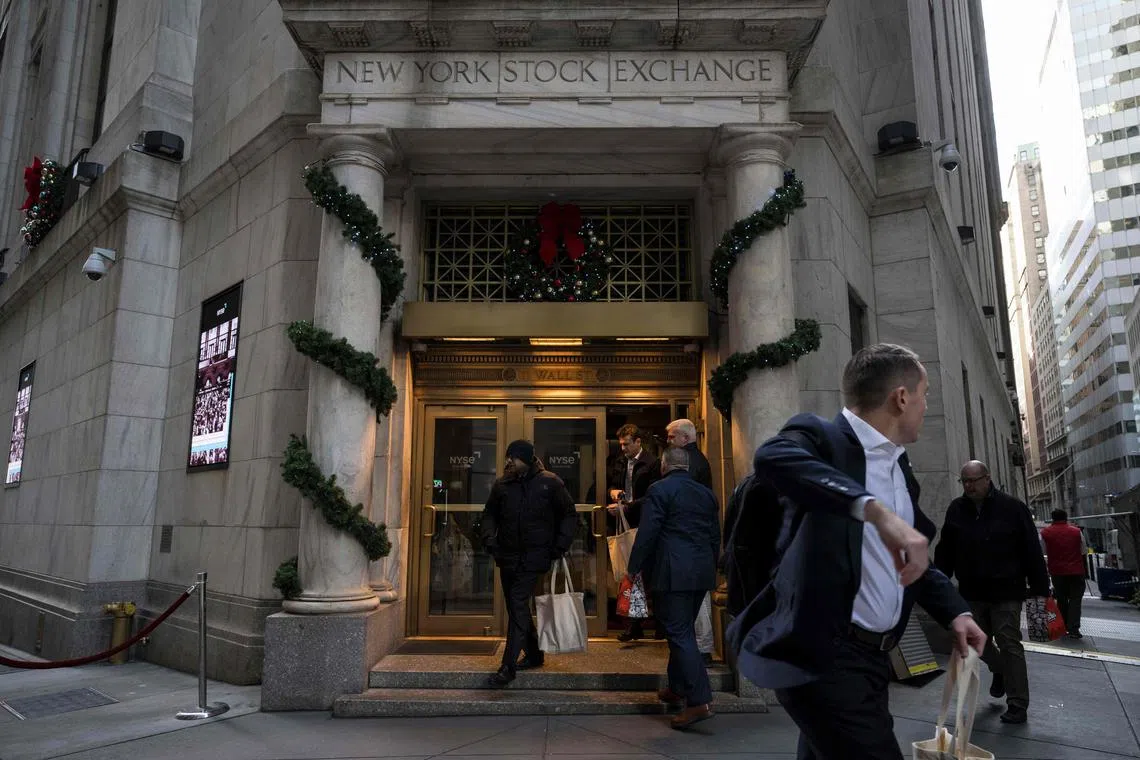Market Watch
Has the market run ahead of itself on rate-cut optimism?
Sign up now: Get ST's newsletters delivered to your inbox

In the US, regional business surveys in December were very weak and the consensus expects some rebound in January.
PHOTO: AFP
Follow topic:
SINGAPORE - Has optimism over an early United States Federal Reserve pivot been overblown, and is the market cruising for a bruising?
That is the question that is being increasingly asked as the market goes through a second consecutive week of turbulence coming into the new year.
After briefly hitting a new high last week, the Dow Jones Industrial Average ended the week at 37,592.98 points for a 0.34 per cent gain for the five days. The S&P 500 was up 1.84 per cent for the week to 4,783.83 points, largely due to gains by tech players.
The continuing strength of tech stocks was reflected in the 3.09 per cent weekly rise of the Nasdaq to 14,972.76 points by Jan 12.
In Singapore, the Straits Times Index (STI) was flattish, gaining just 0.2 per cent for the week to close at 3,191.72 points.
The closely watched 10-year US Treasury yields stayed around 4 per cent for the Asia trading week, while Brent crude oil fluctuated between US$76 per barrel and US$79 per barrel, compared with US$77 per barrel at the end of December 2023.
Oil price firmed slightly as US and British forces hit Houthi targets in Yemen.
The big market-moving data last week was the US consumer price index for December,
Another factor to watch is the growing US government deficit, which continued to pile up during the fourth quarter of 2023, pushing total government debt past a record US$34 trillion (S$45.3 trillion).
Debt as a percentage of US gross domestic product rose to 120 per cent in the third quarter of 2023. Government debt accumulation can lead to stickiness in interest rates.
Going forward, market volatility is likely to continue until we get greater clarity about the outlook for US inflation, interest rates and the economy in the run-up to March, when markets are optimistically projecting that the Fed will start cutting rates aggressively. But Fed officials are already hinting that it might not happen just yet.
Dr Loretta Mester, the Cleveland Fed chief, warned that March is too early for a rate cut after last week’s sticky US consumer price index report for December showed the Fed has “more work to do”.
Richmond Fed chief Thomas Barkin also reiterated last week that he still needs to be convinced that inflation is headed towards the US central bank’s 2 per cent goal.
Dr Raphael Bostic, the Atlanta Fed chief who was the first Fed official to suggest that the US central bank stop raising rates, has said recently that he sees the first rate cut only in the third quarter of 2024 and only two in total in the year.
And Fed governor Michelle Bowman has also cautioned that rate cuts are not imminent.
So the question is: Has the market run ahead of itself? It is a tough question to answer.
Both global equities and bonds have done well so far in 2024, posting gains of between 3 per cent and 5 per cent in US-dollar terms, based on their corresponding MSCI indexes.
Given the general optimism, there is more upside. The question is when. And what should investors be buying into?
In a 2024 market-outlook briefing held for clients last week, DBS Bank said the spotlight for the first half of 2024 would be on fixed income, with investment-grade corporate bonds offering favourable risk-reward.
“We expect this to continue, with elevated bond yields posing a high bar for equities to clear,” DBS said in a chief investment officer report.
This is a point which UBS also repeated. In its outlook paper for the year, the bank said that despite yield volatility, it expected “positive returns for quality bonds across a range of market scenarios in 2024”.
“In equities, we continue to see quality stocks as a core holding for investors,” UBS added. “History shows that they tend to outperform in periods of slowing economic growth, as we expect in our base case. We keep a most preferred stance on the US information technology sector, home to many quality stocks. By also complementing core holdings in quality stocks with tactical exposure to small caps, investors should be well positioned to capture more upside if markets continue to move higher.”
In short, investors should have exposure to both high-grade corporate bonds and good-quality stocks in 2024. This also applies to Singapore.
Interestingly, while the STI itself seems to be dribbling sidewards in moribund fashion, there is quite a bit of activity beneath the surface.
Since the beginning of 2024, some of the most active stocks on the Singapore bourse which have attracted the highest net inflow from institutions relative to their market capitalisation were Geo Energy Resources, Sats, Yangzijiang Shipbuilding, Manulife US Reit, Rex International Holding, Venture Corp, ComfortDelGro Corp, Valuetronics Holdings, Sembcorp Industries, Medtecs International Corp, Keppel Reit, Chasen Holdings, UOL Group, UOB, Aims Apac Reit, Riverstone Holdings, Frasers Centrepoint Trust, Daiwa House Logistics Trust, Suntec Reit and Thai Beverage.
Out of these stocks, Chasen Holdings, Yangzijiang Shipbuilding, Sats and Thai Beverage also ranked among the top 10 price performers for the 100 most active stocks over the first two weeks of 2024.
Other stocks that made it to the top 10 were Beng Kuang Marine, Cosco Shipping International, Samudera Shipping Line, Frasers Property, Best World International and Top Glove.
Going forward, Mr Vasu Menon, managing director for investment strategy at OCBC Bank, sees Fed policy as the key driver of the markets in 2024.
“At this juncture, we think that the Fed will want to see more evidence that inflation will return closer to its 2 per cent inflation target before signalling that interest rates can be reduced,” he said. “We are of the view that the Fed funds rate will be cut by 25 basis points each quarter only from June, making for a total rate cut of 75 basis points this year – half of what markets are expecting currently.”
Looking to the week ahead, a slew of economic data this week will offer further clues about the outlook for the global economy. These could either test or validate market expectations for a soft landing.
In the US, regional business surveys in December were very weak, and the consensus expects some rebound in January. However, the economy appears to be losing some momentum. The same applies to retail sales, data on which will be released this week.


